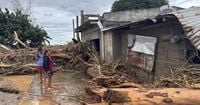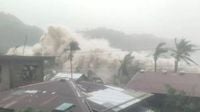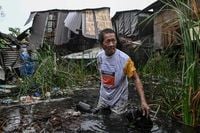As dawn broke over Luzon on November 10, 2025, the Philippines awoke to the aftermath of Super Typhoon Fung-wong—a storm that swept through the country’s most populous island with unrelenting force, leaving a trail of destruction, heartbreak, and resilience. The typhoon, which made landfall in Aurora province on the evening of November 9, unleashed sustained winds of up to 185 kilometers per hour (115 mph) and gusts reaching 230 km/h (143 mph), according to state forecasters cited by multiple outlets including Reuters and the Associated Press.
For many, the night was a sleepless ordeal. "We could not sleep because of the winds hitting our metal sheets and tree branches falling," Romeo Mariano, a resident of Isabela province, told Reuters. When Mariano and his grandmother finally ventured outside, they saw the damage that had been wrought—twisted metal, fallen trees, and battered homes, a scene echoed across dozens of communities in northern Luzon.
Fung-wong’s impact was both immediate and widespread. The storm set off floods and landslides, knocked out power to entire provinces, and displaced more than 1.4 million people. As reported by AFP and the Associated Press, at least six people lost their lives: one person drowned in flash floods in Catanduanes, another died when her house collapsed in Catbalogan City, Samar province, three children were killed in landslides in Nueva Vizcaya, and an elderly person perished in a mudslide in Mountain Province. Authorities noted that, as of November 10, no additional missing persons had been reported—a small mercy amid the chaos.
Rescue and recovery efforts began in earnest on Monday morning, with thousands of Philippine Coast Guard, police, and military personnel fanning out across Luzon. In Dipaculao, where power remained out, crews brandished axes and saws, hacking through debris that included felled trees and entire metal roofs. "We’re seeing many damaged houses and some of our main roads were not passable due to landslides," rescue worker Geofry Parrocha told AFP. "We couldn’t mobilise last night because the rain was heavy and the volume of water was high."
The scale of displacement was staggering. Over 1.4 million people had sought refuge with relatives or in emergency shelters before the typhoon’s arrival, and nearly 320,000 remained in evacuation centers as of Monday, government officials said. In total, at least 132 villages in northern Luzon suffered flooding, with about 1,000 homes damaged. In some villages, residents were trapped on their roofs as floodwaters rapidly rose, a harrowing reminder of the storm’s unpredictability and power.
As the storm raked across mountainous northern provinces and agricultural plains, it weakened but continued to pose risks. The Philippine weather bureau, PAGASA, warned that up to 200 mm (8 inches) of rain could still fall in provinces like La Union, Pangasinan, Benguet, and Zambales through Monday, with gale-force winds threatening coastal and upland areas. Flash flooding was also reported in the Bicol region, where streets in towns like Guinobatan turned into raging torrents.
Schools and most government offices were ordered closed on Monday and Tuesday, and transportation was severely disrupted. More than 325 domestic and 61 international flights were canceled over the weekend and into Monday, leaving over 6,600 commuters and cargo workers stranded in ports after the coast guard prohibited ships from venturing into rough seas, according to the Associated Press and local news agencies.
President Ferdinand Marcos Jr. had declared a state of emergency on November 6, anticipating the extensive devastation caused by Typhoon Kalmaegi just days earlier and the expected damage from Fung-wong, which is also known locally as Uwan. Kalmaegi had already left 224 dead in the central provinces before moving on to Vietnam, where it claimed at least five more lives. The Philippines did not call for international aid after Kalmaegi, but Defense Secretary Teodoro indicated that the United States and Japan stood ready to assist if needed.
Fung-wong is the 21st typhoon to hit the Philippines in 2025, underscoring the nation’s vulnerability to natural disasters. As the storm moved northwest over the South China Sea, it was forecast to strike Taiwan’s western coast by November 12, with heavy rains expected in the island’s eastern and southern regions, according to Taiwan’s Central Weather Administration and the Taipei Times. Taiwanese authorities ordered evacuations in towns like Guangfu, which had suffered deadly floods in September, and placed disaster response teams on standby.
The human cost of Fung-wong was deeply felt. In Nueva Vizcaya, a mudslide buried a house, killing two children—a tragedy confirmed by regional civil defense official Alvin Ayson. In Catanduanes, a resident drowned in flash floods, while in Catbalogan City, Samar, a woman died when her house collapsed, reportedly while she was attempting to retrieve something she had left inside. "The wind was so strong and the rain was heavy," rescuer Juniel Tagarino told AFP. "According to her family members, she might have forgotten something and went back inside her house."
Landslides isolated at least four towns in Aurora province, where the typhoon first made landfall. The Office of Civil Defense’s Bernardo Rafaelito Alejandro IV emphasized the ongoing danger: "While the typhoon has passed, its rains still pose a danger in certain areas in northern Luzon, including in metropolitan Manila. We’ll undertake today rescue, relief and disaster-response operations."
Despite the severity of the storm, early indications suggested that the overall tally of dead "will be minimal," according to civil defense senior official Raffy Alejandro, as damage assessments continued. Nevertheless, the disruption to daily life was acute—homes were damaged, communities isolated, and basic services interrupted.
Scientists have long warned that climate change is making storms like Fung-wong more powerful. Warmer ocean waters enable typhoons to strengthen rapidly, and a warmer atmosphere holds more moisture, resulting in heavier rainfall. The Philippines, situated in the path of the Pacific’s most violent storms, faces about 20 typhoons and tropical storms each year. The country’s vulnerability is compounded by frequent earthquakes and more than a dozen active volcanoes, making it one of the world’s most disaster-prone nations.
As the Philippines moves from rescue to recovery, the resilience of its people is once again on display. While the immediate threat from Fung-wong has passed, the work of rebuilding—of clearing debris, restoring power, and reopening schools and roads—has only just begun. With another typhoon season still ahead, the nation steels itself for the challenges that lie ahead, drawing on hard-won experience and the enduring spirit of its communities.


